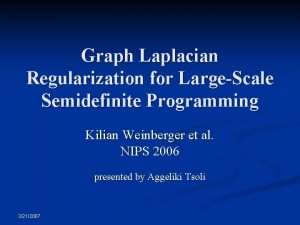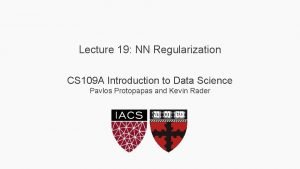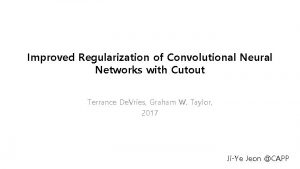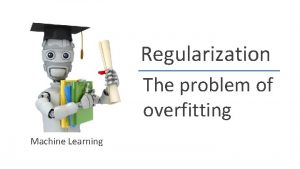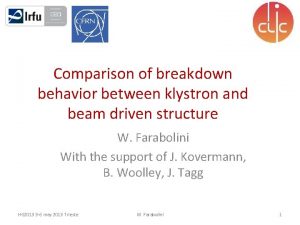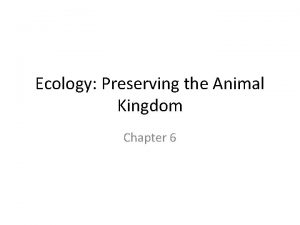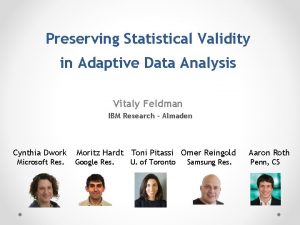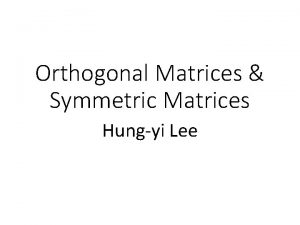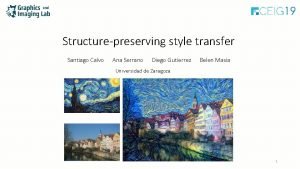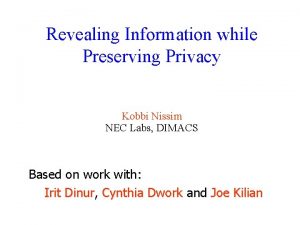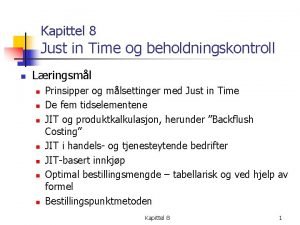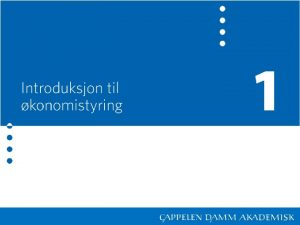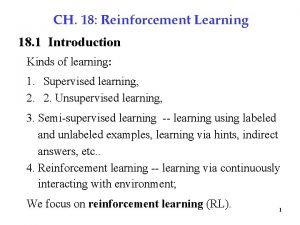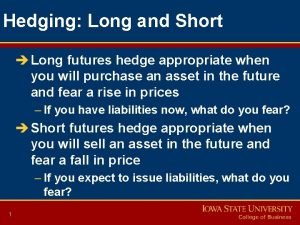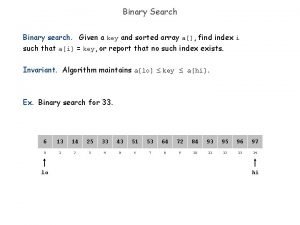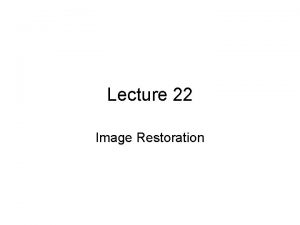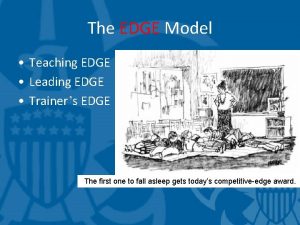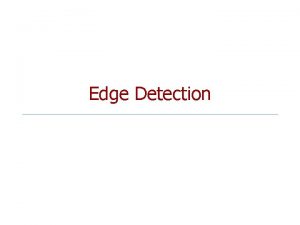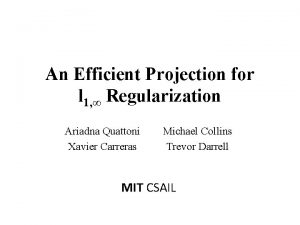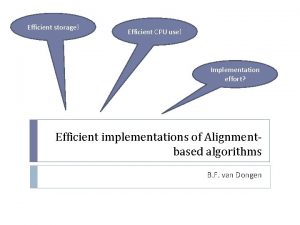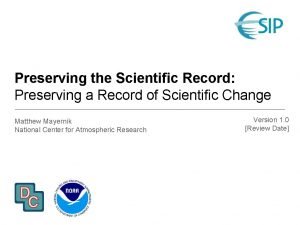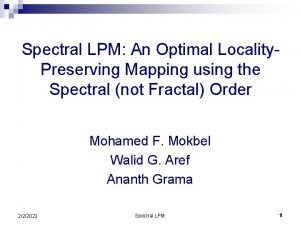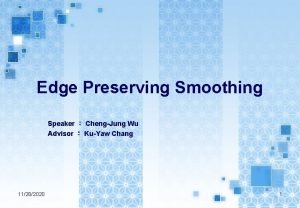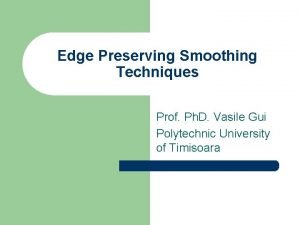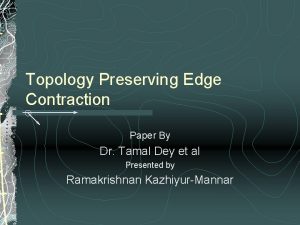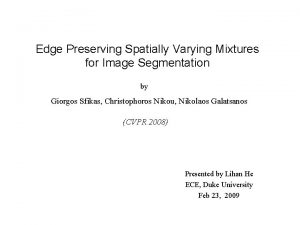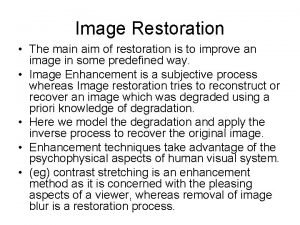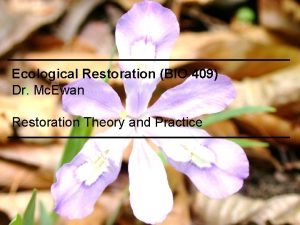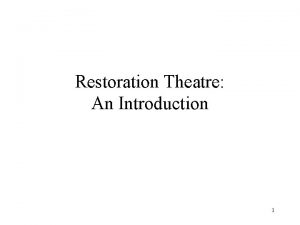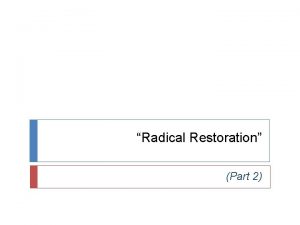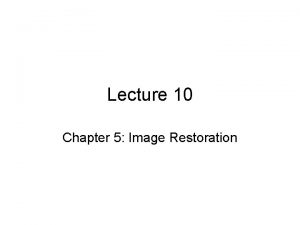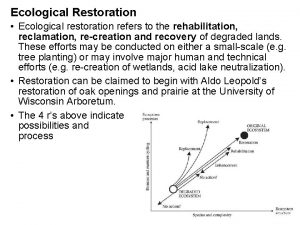Optimal edge preserving restoration with efficient regularization Seminar


























- Slides: 26

Optimal edge preserving restoration with efficient regularization Seminar By Dr. M. Arfan Jaffar Mohsin Bilal, M. A. Jaffar, Optimal edge preserving restoration with efficient regularisation, The Imaging Science Journal, 63(2): 68 -75. 2015 (indexed by ISI Impact Factor 0. 598). 1/4/2022 Seminar Presentation 1

Presentation Outline Ø Introduction: � Ø Proposed Methods for SID � Ø 1/4/2022 Spatial Degradations Optimal Restoration with Regularization Conclusion & Future Work Seminar Presentation 2

Introduction • During image acquisition, it is quite unavoidable to have a faithful representation of the scene to be recorded. • Hence every recorded image is more or less blurry. • Blurring is the linear process which spreads the scene information to the neighboring pixels; eventually, the loss of small scale details happens • Point spread function (PSF) is the general model that can result the same blurring effect if an image is convolved with it. • Causes of Blurring: imaging technology limitation of resolution and recording speed. • Atmospheric turbulence, camera or object motion during recording, object occurrence outside the depth of field of recording device, all these situations yield blur, motion blur and out of focus blur respectively in the recorded image. 1/4/2022 3

Introduction – Image Restoration Ø To deal with images degraded with blur, noise or both. Ø Image restoration attempts to obtain the original image given the degraded image with some knowledge of degradation factors Ø Image Restoration of spatial degradations is an interesting field providing challenging problems. Optimization of the ill-posed inverse problem Ø Dealing with conflicting objectives - making a tradeoff between smoothness and sharpness. Ø Degraded Image Information about Image Acquisition Degraded Image 1/4/2022 Formulation of Degradation Model Inverse Degradatio n Process Estimated Image 4

Spatial Degradations Ø Common degradations are blur, noise and motion. Ø Space invariant Degradation (SID) - Image suffers degradation with a single blurring kernel or Point Spread Function (PSF). Ø Space Variant Degradation (SVD) - different spatial locations suffer different form of degradation i. e. different spatial locations have different PSF. Ø Generally, caused by problems with the imaging system such as distortions in optical system, global lack of focus, object being outside the depth of camera’s field or camera 1/4/2022 motion 5

Space invariant Degradation Model � 1/4/2022 Seminar Presentation 6

Restoration of SID � 1/4/2022 Seminar Presentation 7

Adaptive Restoration via Regularization � 1/4/2022 8

Proposed Regularization Ø Regularization term: Ø Difference of every gray value with the average of all gray values in the estimated solution. � where x is the m-dimensional vector of the estimated image, and xp is the grey value of pixel at location p in the estimated solution x. �The regularization parameter : is a ratio between fidelity term (the difference between the estimated solution with the degraded image) and the proposed regularization term, (the difference of every pixel with the average of all grey values) 1/4/2022 Seminar Presentation 9

Restoration by Optimization Ø Ø Ø 1/4/2022 In order to search for the optimal solution, a gradient based approach is used based upon the idea of steepest descent, which searches for the estimate of x which minimized following error function Restoration by searching global minima for: The search is performed by steepest descent algorithm, which moves the estimate in the gradient direction: Seminar Presentation 10

Performance Measures Most commonly used performance measures for Image Restoration include: Ø Signal-to-noise-ratio (SNR) Ø Peak-signal-to-noise-ratio (PSNR): Ø It is a global performance measure Ø PSNR can be defined as 1/4/2022 11

Results Blur operator ‘H’ comprising of 3*3 Gaussian PSF kernel with the std ‘ 2’ 1/4/2022 Seminar Presentation 12

Result of proposed algorithm with varying PSF sizes 1/4/2022 Seminar Presentation 13

Experimental Results (a) (c), 16. 03 (b), 8. 22 (d), 16. 93 (e), 19. 45 (a) Original (b) Degraded (c) Neural Network (d) Mignotte and (e) Proposed Solution 1/4/2022 Seminar Presentation 14

Comparative Analysis 1/4/2022 Image Restoration Techniques ΔSNR Space Variant Adaptive 2. 07 HNN Algorithm 5. 94 Harmonic Algorithm 6. 49 Total Variation algorithm 9. 55 Spatially Adaptive Image Restoration 5. 27 Multiscale neural network Technique 7. 81 Biouscas – Dias 8. 10 Mignotte 8. 71 Proposed Solution 11. 43 Seminar Presentation 15

Summary Ø An efficient gray scale average based regularization term is proposed for the smoothness of solution in objective function. Ø Restoration estimate is obtained iteratively by applying steepest descent approach. 1/4/2022 16

Cross-Cultural Emotion Classification based on Incremental Learning and LBP-Features Sultan Zia, M. A. Jaffar, Cross-Cultural Emotion Classification based on Incremental Learning and LBP-Features, Applied Mathematics & Information Sciences, 9, No. 5, 2651 -2656 (2015)

Introduction �A number of studies have shown that facial expression representations are cultural dependent and not universal. �Most facial expression recognition (FER) systems use one or two datasets for training and same for testing and show good results. �While their performance mortify radically when datasets from different cultures were presented. �To keep high accuracy for a long time and for all cultures, a FER system should learn incrementally. �We proposed a FER system that can offer incremental learning capability. �Local Binary Pattern (LBP) Features are used for Region of Interest (ROI) extraction and classification. �We used static images of facial expressions from different cultures for training and testing. 1/4/2022 Seminar Presentation 18

Introduction �Automatic FER is still a challenging problem due to illumination, head pose, aging, glasses, cultures and races. �Even, human cannot 100% recognize facial expressions due to many reasons. �First, different people interpret expressions differently for example, fear expression images, which interpreted as fear in America and most of the other countries are mostly interpreted as surprise in Japan. �Second, people from different cultures think about facial expressions in different ways, for example, in some cultures, people focus on mouth but in others focus on eyes etc. �Third, in different cultures expressions are expressed in different ways i. e. not all the facial expressions are innate and universal. 1/4/2022 Seminar Presentation 19

1/4/2022 Seminar Presentation 20

1/4/2022 Seminar Presentation 21

1/4/2022 Seminar Presentation 22

� Five datasets used JAFFE, Cohn Kanade, MUG, FEEDTUM and our own dataset of colored images of Indian subcontinent people, movies and videos 1/4/2022 Seminar Presentation 23

1/4/2022 Seminar Presentation 24

1/4/2022 Seminar Presentation 25

Conclusion �A proposed a method for automatic facial expression classification using incremental learning and local binary patterns histogram features. �The proposed system has ability to learn incrementally and can accommodate future data. �Due to incremental learning ability it can accommodate itself in different cultures. �The experimentation performed is showing promising results. 1/4/2022 Seminar Presentation 26
 Productively efficient vs allocatively efficient
Productively efficient vs allocatively efficient Productively efficient vs allocatively efficient
Productively efficient vs allocatively efficient Allocative efficiency vs productive efficiency
Allocative efficiency vs productive efficiency Allocative efficiency
Allocative efficiency C b a d
C b a d Graph laplacian regularization
Graph laplacian regularization Nn regularization
Nn regularization Cutout regularization
Cutout regularization Regularized cost function
Regularized cost function Rising edge and falling edge
Rising edge and falling edge Ecology preserving the animal kingdom
Ecology preserving the animal kingdom Preserving statistical validity in adaptive data analysis
Preserving statistical validity in adaptive data analysis Orthonormal matrix
Orthonormal matrix Preserving your credit
Preserving your credit Structure-preserving neural style transfer
Structure-preserving neural style transfer Preserving your credit
Preserving your credit Preserving food
Preserving food âq1
âq1 Dr nuzhat sultana
Dr nuzhat sultana Optimal bestillingsmengde
Optimal bestillingsmengde Styringssløyfen
Styringssløyfen What is optimal policy in reinforcement learning
What is optimal policy in reinforcement learning Dr. amy ford
Dr. amy ford Short futures hedge
Short futures hedge Optimal binary search tree
Optimal binary search tree Hunger games hierarchy
Hunger games hierarchy Teori level optimal adalah
Teori level optimal adalah





